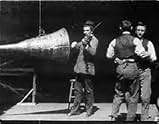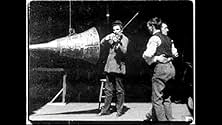IMDb रेटिंग
6.7/10
2.7 हज़ार
आपकी रेटिंग
अपनी भाषा में प्लॉट जोड़ेंThe earliest extant sound film, but the phonograph soundtrack has been lost. It depicts William K.L. Dickson standing in the background next to a huge sound pickup horn connected to a Thomas... सभी पढ़ेंThe earliest extant sound film, but the phonograph soundtrack has been lost. It depicts William K.L. Dickson standing in the background next to a huge sound pickup horn connected to a Thomas Edison phonograph recorder.The earliest extant sound film, but the phonograph soundtrack has been lost. It depicts William K.L. Dickson standing in the background next to a huge sound pickup horn connected to a Thomas Edison phonograph recorder.
- निर्देशक
- स्टार
- पुरस्कार
- कुल 1 जीत
William K.L. Dickson
- Violinist
- (बिना क्रेडिट के)
फ़ीचर्ड समीक्षाएं
The Library of Congress has discovered the missing sound-track for this film, which was at the Edison National Historical Site all along. It was a cylinder, broken in half, labelled "WKL Dickson Violin with Kineto" and it has recently been repaired, transcribed, and put in synch with the image. This short film now takes its place as the oldest existing sound film. Before the image starts, you can just hear someone saying "Are the rest of you ready? Go ahead!"
"The synchronized sound version was restored in 2000 by Walter Murch, Rick Schmidlin, Industrial Light and Magic and Skywalker Sound, which is a division of Lucas Digital, Ltd., LLC (a George Lucas company) in collaboration with the Library of Congress and the Edison National Historic Site."....IMDB.
I won't rate this film, as it's just too short and is a purely experimental film that was never released back in the day. It consists of a guy playing the violin into a gigantic cornucopia-like device attached to an Edison cylindrical recording device. As he plays, two guys dance about with each other (in a father familiar manner). Towards the end, some other guy shows up for no apparent reason.
This is not a fun film you should rush to show all your friends. However, it IS historically significant as one of the first sound films...albeit crudely made. Well worth seeing for film historians and nuts like me.
I won't rate this film, as it's just too short and is a purely experimental film that was never released back in the day. It consists of a guy playing the violin into a gigantic cornucopia-like device attached to an Edison cylindrical recording device. As he plays, two guys dance about with each other (in a father familiar manner). Towards the end, some other guy shows up for no apparent reason.
This is not a fun film you should rush to show all your friends. However, it IS historically significant as one of the first sound films...albeit crudely made. Well worth seeing for film historians and nuts like me.
Some commentors note that this is of historic importance. But the point is precisely that it is not.
Film is like everything else, but moreso. It is what it is because of a process of evolution, accident, selfish urges and technology circumstance. Film affects us profoundly, indeed defines large parts of our lives. The unhappy fact is that what it makes in us is twisted by its past, how it got to us.
So our worlds have all sorts of legacies of its accidental past, just as our bodies have vestigial tails and gills. You just cannot be a person at all unless you know who you are, and part of that self-discovery is in understanding the snowball of cinema.
This isn't part of that snowball because the technology was forgotten, almost as if it never happened. Maybe if they worked late one night, if it hadn't rained, if a joke hadn't been so funny, it would have become part of the medium.
Then we would have avoided all that adventure in pantomime and shadow that forms the nervous system of our images today.
See this as a reminder of all the extinct possibilities that were pruned from what we have. Maybe it will help illuminate what wasn't pruned.
Ted's Evaluation -- 3 of 3: Worth watching.
Film is like everything else, but moreso. It is what it is because of a process of evolution, accident, selfish urges and technology circumstance. Film affects us profoundly, indeed defines large parts of our lives. The unhappy fact is that what it makes in us is twisted by its past, how it got to us.
So our worlds have all sorts of legacies of its accidental past, just as our bodies have vestigial tails and gills. You just cannot be a person at all unless you know who you are, and part of that self-discovery is in understanding the snowball of cinema.
This isn't part of that snowball because the technology was forgotten, almost as if it never happened. Maybe if they worked late one night, if it hadn't rained, if a joke hadn't been so funny, it would have become part of the medium.
Then we would have avoided all that adventure in pantomime and shadow that forms the nervous system of our images today.
See this as a reminder of all the extinct possibilities that were pruned from what we have. Maybe it will help illuminate what wasn't pruned.
Ted's Evaluation -- 3 of 3: Worth watching.
Quite a curiosity both technically and in its content, this very brief experimental film is an important part of the early history of the movies. It shows how very early in the history of cinema that film-makers hoped to synchronize sound with motion pictures, and perhaps also shows how close they came. If an early attempt like this had succeeded in making it possible to create 'talking' pictures while the whole industry was still in its earliest stages, it seems possible that movie history could well have developed in quite different ways than it actually did.
As it has now been reconstructed using more recent technology, from the film footage and the remains of the original sound cylinder, the sound quality is surprisingly good. In itself, it is not all that far from the sound in much later experiments like the 1925 Theodore Case movie starring Gus Visser, and to early part-sound releases like "The Jazz Singer". Since the initial filming succeeded in its goal, the snags with this attempt seem all to have come in playback, when every attempt at synchronization failed, leaving it to much later film-makers to solve that problem.
The unusual content also makes it a curiosity, as is evidenced by the sometimes widely varying responses to it. It would have been more expected for an experiment like this to use amusing but innocuous subject matter, as Case did much later with Visser's vaudeville act.
As short as the footage of this movie is, it has considerable interest as a piece of movie history, and it's even possible that there is still more to be learned about it.
As it has now been reconstructed using more recent technology, from the film footage and the remains of the original sound cylinder, the sound quality is surprisingly good. In itself, it is not all that far from the sound in much later experiments like the 1925 Theodore Case movie starring Gus Visser, and to early part-sound releases like "The Jazz Singer". Since the initial filming succeeded in its goal, the snags with this attempt seem all to have come in playback, when every attempt at synchronization failed, leaving it to much later film-makers to solve that problem.
The unusual content also makes it a curiosity, as is evidenced by the sometimes widely varying responses to it. It would have been more expected for an experiment like this to use amusing but innocuous subject matter, as Case did much later with Visser's vaudeville act.
As short as the footage of this movie is, it has considerable interest as a piece of movie history, and it's even possible that there is still more to be learned about it.
The broken sound "cylinder" for this 1894 film was found in the 1960's and repaired in 1998, so film enthusiasts take heart, we might be finding some lost films twenty years from now!
In 1913 Edison announced that all the problems with talking pictures had been solved - his pronouncement was somewhat premature, and the assumption that Edison was right prevented the success of a couple of European inventors that came to the U.S. seeking financial backing for systems that might have worked in the 1910's, including a sound on film system.
Synchronizing movement and sound was not too hard - although this film was not a true attempt at synchronization. It was synchronizing speech and film in a manner such that the results looked the least bit natural and were the least bit repeatable that were the sustained problems.
And about my precode comment, Joe Breen, head censor in America from 1934 to 1952, would never allow two men to dance together in a film under any circumstance. The last time that was tried in an American film prior to the production code was "Wonder Bar" in 1934, with Al Jolson looking on, rolling his eyes, and making the remark "boys will be boys!". Although, in fairness, this film was never exhibited to the public, and the two dancing men were probably workers in Dickson's lab, the female engineer being a rarity in 1894.
In 1913 Edison announced that all the problems with talking pictures had been solved - his pronouncement was somewhat premature, and the assumption that Edison was right prevented the success of a couple of European inventors that came to the U.S. seeking financial backing for systems that might have worked in the 1910's, including a sound on film system.
Synchronizing movement and sound was not too hard - although this film was not a true attempt at synchronization. It was synchronizing speech and film in a manner such that the results looked the least bit natural and were the least bit repeatable that were the sustained problems.
And about my precode comment, Joe Breen, head censor in America from 1934 to 1952, would never allow two men to dance together in a film under any circumstance. The last time that was tried in an American film prior to the production code was "Wonder Bar" in 1934, with Al Jolson looking on, rolling his eyes, and making the remark "boys will be boys!". Although, in fairness, this film was never exhibited to the public, and the two dancing men were probably workers in Dickson's lab, the female engineer being a rarity in 1894.
क्या आपको पता है
- ट्रिवियाThe synchronized sound version was restored in 2000 by Walter Murch, Rick Schmidlin, Industrial Light and Magic and Skywalker Sound, which is a division of Lucas Digital, Ltd., LLC (a George Lucas company) in collaboration with the Library of Congress and the Edison National Historic Site.
- भाव
Man: Are the rest of you ready? Go ahead!
- कनेक्शनFeatured in The Miracle of Sound (1940)
- साउंडट्रैकThe Chimes of Normandy
(1877) (uncredited)
(Originally called "Les cloches de Corneville (The Bells of Corneville)"
Written by Robert Planquette
Small section played on violin by William K.L. Dickson
टॉप पसंद
रेटिंग देने के लिए साइन-इन करें और वैयक्तिकृत सुझावों के लिए वॉचलिस्ट करें
विवरण
- चलने की अवधि
- 1 मि
- रंग
- पक्ष अनुपात
- 1.33 : 1
इस पेज में योगदान दें
किसी बदलाव का सुझाव दें या अनुपलब्ध कॉन्टेंट जोड़ें















